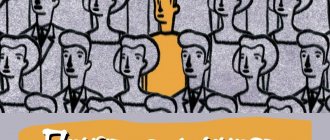Concept of activity
Activity is considered the basis for the development of a person as an individual, the main factor in his existence as a social being.
Mastering an activity, its complication, and improvement is an important condition for the development of the human nervous system. To solve educational problems, it is necessary to be based on psychological patterns and the dynamics of human activities. When carrying out educational actions, it is necessary to take into account the nature of various types of activities, their features, meaning, content and volume. The concept of personality and activity in Russian psychology are considered as interconnected phenomena. When developing the problem of activity and activity of the individual, modern psychology is based on the idea of the functional nature of reflection, the origin of consciousness from work activity, and the leading role of work in human behavior and activity. The source of activity is called, first of all, needs. It is needs that push a person to search for means to satisfy it, which entails active activity.
Are you an expert in this subject area? We invite you to become the author of the Directory Working Conditions
Based on their origin, needs can be divided into natural and cultural, and are characterized by the following indicators:
- any need has its own object, that is, it is continuously an awareness of the need for something.
- any need receives a certain content depending on the criteria and methods of its satisfaction.
- the need has the ability to be reflected.
- needs are expressed in motives, that is, in some incentives for activity.
Each type of activity has its own special motives.
The role of heredity in the development of human personality
Heredity refers to the reproduction of biological similarities with parents in offspring.
Heredity is the genetic program of an individual that determines his genotype.
The hereditary programs of human development contain deterministic and variable parts that determine both what makes a person human and what makes people so different from each other.
- the deterministic part of the hereditary program primarily provides for the continuation of the human race, as well as the specific characteristics of man as a representative of the human race, including characteristics of speech, locomotion, labor activity, and thinking.
- external characteristics: Features of physique, constitution, hair color, eyes and skin are passed on from parents to children. 3.
- the combination of various proteins in the body is strictly genetically programmed, blood groups and the Rh factor are fixed.
- blood diseases (hemophilia), diabetes mellitus, some endocrine disorders - dwarfism is inherited.
- hereditary characteristics include features of the nervous system that determine the nature and characteristics of mental processes.
- the ability to perform various types of activities is inherited.
Every child has four groups of natural abilities: intellectual, artistic and social. Attributes are a natural condition for the development of abilities. A few words should be said about intellectual (cognitive, educational) tasks. All normal people by nature have a high potential for developing their mental and cognitive abilities.
Existing differences in the types of higher nervous activity affect only the course of thought processes, but do not determine the quality and level of intellectual activity itself. But teachers and psychologists believe that there may be unfavorable heredity for the development of intellectual abilities. For example, negative predispositions cause sluggishness of brain cells in children of alcoholics, disruption of genetic structures in drug addicts, and hereditary mental illnesses.
The issue of inheritance of moral qualities and psyche is very important. The leading position of Russian pedagogy was the assertion that all mental and moral qualities of an individual are not inherited, but acquired in the process of interaction of the organism with the external environment. A person is born neither evil nor kind, neither generous nor stingy, not to mention evil and criminal. Children do not inherit the moral traits of their parents; Human genetic programs do not contain information about social behavior.
In Western pedagogy, the prevailing view is that a person’s moral qualities are determined biologically. People are born good or bad, honest or deceptive, a person is born with belligerence, aggressiveness, cruelty, greed (M. Montessori, K. Lorenz, E. Fromm, A. Miherlik, etc.).
Recently, domestic experts have also defended their position on the genetic determination of social behavior. Academicians P.K. Anokhin, N.M. Amosov and others argue that heredity determined human morality and social behavior.
Motives for activity
The development of activity entails the emergence of its various types and forms (play, work, learning), which are connected and subordinated. In this case, a hierarchical relationship of motives is established that are incentives for various types of activities. Such a unified system of motives for activity, which arises in their development, constitutes the emotional basis of the individual.
Sometimes monotonous motives can be manifested differently in behavior, and different motives have every chance of having the same outward forms of manifestation in behavior. For example, participation in public works, prompted by rivalry, the desire to be first among comrades, is not the same as the child’s desire to benefit his own class. Depending on the child’s motives, different personality traits are formed (in the example provided, individualism and collectivism).
Finished works on a similar topic
Course work Activity and activity as conditions for personality development 480 ₽ Abstract Activity and activity as conditions for personality development 270 ₽ Test work Activity and activity as conditions for personality development 240 ₽
Receive completed work or specialist advice on your educational project Find out the cost
Behavior is most often stimulated not by one, but by several motives at once, which differ in content and structure. Among them there are leaders and subordinates. The formation of the motivational sphere of the individual is characterized precisely by a change in leading motives, the creation of the highest moral motives. The necessary changes in the correlation of motives and their hierarchy are guaranteed by the purposeful organization of activities. That is why in psychology there is a concept of a system of motives and motivation.
School-age children participate in a large number of different types of activities, each of which is characterized not only by the specific composition of different types of activities, but also by the presence of a leading activity. In it, its own psychological processes appear, are created or rebuilt (in learning - theoretical thinking, in play - fantasy, etc.), the key mental changes of each period of the child’s development depend on it (a preschooler, for example, in play masters the main social functions and norms of human behavior).
The famous Russian psychologist A. N. Leontyev wrote that some types of activities play a major role in development, others play a subordinate role, so we need to talk about the dependence of mental development on the leading activity:
- During preschool childhood, the main activity of children is considered to be play. The game expands the child’s horizons, develops mental capabilities (hypothesis, intelligence, resourcefulness), and creates character traits and moral properties. Along with play, work activity acquires great meaning in the life of a preschooler. Adults include the child in self-care work, equip him with basic skills and abilities, and form moral and volitional properties. Taking into account the age of children, parents, teachers and educators often combine play and work activities;
- When a child enters school, teaching becomes the main activity. It endlessly expands children’s horizons, guarantees the creation of opinions, and contributes to their deepening and clarification. During training, schoolchildren master teaching methods and get the opportunity to learn a lot not only from the words of the teacher, but also from books and conversations with elders;
- During children's independent activities, their cognitive activity develops. It becomes the most powerful catalyst for their diversified development;
- While studying at school, work becomes more and more meaningful.
Activity as a leading factor in the development of personality and society. article on the topic
Activity as a leading factor in the development of the individual and society.
The relevance of this topic is due to the fact that a person becomes a person through work and communication. K. Marx and F. Engels argued: - “Personality is not an integrity determined genetically: one is not born a person, one becomes a person.” Joint work is impossible without mutual exchange of ideas, intentions, and thoughts. But it also presupposes the need to know what a labor participant is. This knowledge is obtained mainly in the process of activities that are carried out jointly. A person is judged not by what he says or thinks about himself, but by what he does. Based on this, it can be assumed that in unity with the need to say something to each other about a common cause, there is also a need to somehow show oneself to each other, to highlight one’s contribution to the common cause, to be in the best possible way, understood and appreciated by others. A person’s need to be a person becomes a condition for the formation in other people of the ability to see him as a person. By distinguishing himself as an individual, achieving a comprehensive assessment of himself as an individual, a person in his activity places himself in the community as a necessary condition for its existence. And the comprehensive development of abilities allows a person, through socially useful activities, to make a positive contribution to other people, to the life of society as a whole.
Personality (English personality; from Latin persona - actor’s mask; role, position; face, personality) - in the social sciences, personality is considered as a special quality of a person acquired by him in the social and cultural environment in the process of joint activity and communication. In humanistic philosophical and psychological concepts, as an example in the works of I. Kant, personality is a person as a value for the sake of which the development of society is carried out. With all the diversity of approaches to understanding personality, the following aspects of this problem are traditionally highlighted:
- the versatility of phenomenology - personality, reflecting the objectively existing diversity of human manifestations in the evolution of nature, the history of society and his own life;
- interdisciplinary status of the problem of personality, located in the field of study of social and natural sciences;
- the dependence of the understanding of personality on the image of a person, openly or hiddenly existing in culture and science at a certain stage of their development;
- the discrepancy between the manifestations of the individual, personality and individuality, studied within the framework of biogenetic, sociogenetic and personogenetic directions of modern human science that are relatively independent from each other;
- dividing a research approach that orients the specialist towards understanding the development of personality in nature and society, and a practical focus aimed at the formation or correction of personality in accordance with the goals set by society or set by a specific person who contacts a specialist.
Representatives of the biogenetic orientation focus on the problems of human development as an individual with certain anthropogenetic properties (inclinations, temperament, biological age, gender, body type, neurodynamic properties of the nervous system, organic impulses, drives, needs, etc.), which go through various stages maturation as the phylogenetic program of the species is implemented in ontogeny. The basis of the maturation of an individual is the adaptive processes of the body, which are studied by differential and age-related psychophysiology, psychogenetics, neuropsychology, gerontology, psychoendocrinology and sexology.
According to the definition of the psychological dictionary by A.V. Petrovsky and M.G. Yaroshevsky activity is a purposeful activity that realizes the needs of the subject. As an explanatory principle of the psyche, the category of activity is used in the study of various areas of mental reality (psychology of cognitive processes, motivation, will, emotions, personality, intragroup processes) and in the construction of various branches of psychology.
The main characteristics of activity are objectivity and subjectivity. The specificity of the objective definition of activity in a broad sense is that the objects of the external world do not directly affect the subject, but only when they are transformed in the process of activity, due to which greater adequacy of their reflection in consciousness is achieved. When analyzing activity, three plans for its consideration are distinguished: genetic, structural-functional and dynamic.
In genetic terms, the initial form of any human activity is social joint activity, and the mechanism of development of the human psyche is an internal structure that ensures the assimilation of socio-historical experience by transforming social joint activity into individual activity. During internalization, there also occurs a transition from activity that is external in form to internal activity.
According to the definition of L.D. Stolyarenko, activity is the active interaction of a person with the environment in which he achieves a consciously set goal that arose as a result of the emergence of a certain need or motive.
Motives and goals may not coincide. Why a person acts a certain way is often not the same as why he acts. When we are dealing with activity in which there is no conscious goal, then there is no activity in the human sense of the word, but impulsive behavior takes place, which is controlled directly by needs and emotions. An act is an action, performing which a person realizes its significance for other people, i.e. its social meaning.
Action has a structure similar to activity: goal - motive, method - result. There are actions: sensory (actions to perceive an object), motor (motor actions), volitional, mental, mnemonic (memory actions), external objective (actions aimed at changing the state or properties of objects in the external world) and mental (actions performed in the internal plane consciousness). The main types of activities that ensure the existence of a person and his formation as an individual are communication, play, learning and work.
Personality development is a process of natural change in personality as a systemic quality of an individual as a result of his socialization. Possessing natural anatomical and physiological prerequisites for the formation of personality, in the process of socialization the child interacts with the outside world, mastering the achievements of mankind. The abilities and functions that develop during this process reproduce historically formed human qualities in the individual. Mastery of reality in a child is carried out in his activities with the help of adults: thus, the process of education is leading in the development of his personality.
Personal development is carried out in activities controlled by a system of motives inherent in a given individual. The activity-mediated type of relationship that a person develops with the most reference group, or in other words, the reference group in the structure of activity, is the determining leading factor in personality development. According to A.V. Petrovsky, needs are the prerequisite and result of personality development. At the same time, an internal contradiction constantly arises between growing needs and real opportunities to satisfy them.
The system of interpersonal relations in groups, in turn, generates a contradiction between the individual’s need for personalization and the group’s objective interest in accepting only those manifestations of his individuality that correspond to the values, tasks and norms of the functioning and development of this community. This contradiction is resolved in joint activities.
In its most general form, personality development can be presented as the process of a person’s entry into a new social environment and integration into it as a result of this process. If an individual enters a relatively stable social community, under favorable circumstances he goes through three phases of his formation as an individual.
- The first phase (adaptation) involves the assimilation of current values and norms and mastery of the corresponding means and forms of activity and thereby, to some extent, making the individual similar to other members of the same community.
- The second phase (individualization) is generated by the growing contradictions between the need to “be like everyone else” and the individual’s desire for maximum personalization, which is characterized by the search for means and ways to designate one’s individuality.
- The third phase (integration) is determined by the contradiction between the individual’s desire to be ideally represented by his characteristics and differences in the community, on the one hand, and the need of the community to accept, approve and cultivate only those of his individual characteristics that contribute to its development and thereby the development of himself as an individual - on the other side.
In Russian psychology, the most famous research in the field of personality is associated with the theoretical works of representatives of the school of L.S. Vygotsky. A.N., in particular, made a significant contribution to solving the problem. Leontv, L.N. Bozhovich. L.N. Bozhovich’s theory consisted of describing the concept of personality in a context characterized by the internal properties and characteristics of a person. Based on the concept of leading activity and the social situation of development, the dynamics of interaction between a person’s activity and interpersonal communication were shown at different periods of his life, the formation of certain views, i.e. internal position. This position is the main characteristic of the personality, a prerequisite for its development, which is the totality of the leading motives of activity.
A.N. Leontyev proposed a concept of the structure and development of personality, in which an important place is given to the concept of activity, the main characteristics being the motivational sphere and “personal meaning”. The wider and more diverse the types of activities in which a person is involved, the more developed and ordered they are, the richer the personality itself.
Speaking about various theories of personality, we must not forget about the French psychological school and its most prominent representative, P. Jean. The ideas expressed by this scientist were subsequently widely developed in the works of the previously mentioned domestic psychologists. Janet expressed the opinion that various mental processes are phenomena that prepare actions. The processes that regulate action are feelings and thinking. Personal development, according to Zhana, is based on teaching and behavior, the meaning of which implies internal mental content, which is part of behavior and a regulatory link. All this contributes to the possibility of regulation and self-regulation of the individual. Janet also believed that the human psyche develops in cooperation with other people, since on the basis of relationships it can regulate its own behavior. P. Janet has an interesting structure of a behavioral act, where three stages are distinguished: internal preparation for action, execution of action and completion of action. We also know that Janet identified different levels of human behavior:
- Reflexive acts
- Delayed perceptual actions, where we can observe the preparation and completion of an action.
- Elementary social acts, as an example - imitation.
- Intellectual acts
- Manipulation of real objects, which leads to the formation of intelligent objects.
- Mental activity, which raised the question of the genetic connection between thinking and action.
- Creative human activity
The position on self-regulation, which has become the cornerstone of the analysis of personality development, echoes Janet’s position on the presence of psychological tension and strength, which helps determine the properties of the individual, the speed and duration of individual actions, the ability to concentrate and distribute force, which, according to Genet, constitutes the activation of higher needs.
Psychological development of human personality according to B.G. Ananyev - a dialectical process, the emergence and resolution of contradictions, the transition from external to internal, self-movement. Active work on yourself. B.G. Ananyev represented the development of personality as increasing in scale and level of integration - the formation of substructures and their increasingly complex synthesis. On the other hand, there is a parallel process of increasing differentiation of mental functions (development, complication, “branching” of mental processes, states, properties)
The typology of students developed by V.T. Lisovsky, i.e. people on average 18-25 years old looks like this:
- "Harmonious". I chose my specialty consciously. He studies very well and actively participates in scientific and social work. Developed, cultured, sociable, deeply and seriously interested in literature and art. Irreconcilable with shortcomings, honest and decent. Enjoys authority in the team as a good and reliable friend.
- "Professional". I chose my specialty consciously. As a rule, he studies well. He rarely participates in research work, as he is focused on postgraduate practical activities. Take part in public work, conscientiously carrying out assignments. Whenever possible, he plays sports, is interested in literature and art, and is honest and decent. He is respected in the team.
- "Academician". I chose my specialty consciously. He studies only with excellent marks. Focused only on studies, he devotes a lot of time to research work, sometimes to the detriment of other activities.
- "Social activist." He is characterized by a pronounced penchant for social activities, which often prevails over other interests and sometimes negatively affects educational activity. However, I am sure that I chose the profession correctly. He is interested in literature and art, and is a leader in the leisure sector.
- "Art Lover" As a rule, he studies well, but rarely participates in scientific work, since his interests are focused mainly in the field of literature and art. He is characterized by a developed aesthetic taste, a broad outlook, and deep artistic erudition.
- "Diligent". I chose my specialty not entirely consciously, but I study conscientiously, making every effort. And although he does not have developed abilities, as a rule, he does not have debts. Uncommunicative in a team. He has little interest in literature and art, since studying takes up a lot of time.
- "Middle peasant." He learns “as best he can” without making much effort. And he’s even proud of it. When choosing a profession, I didn’t think much about it, but I’m convinced that once I’ve entered, I need to finish university, and I don’t feel much pleasure from studying.
- "Disappointed". The person is usually capable. But the chosen specialty turned out to be unattractive. However, I am convinced that once I entered, I should graduate from college; I don’t feel much pleasure from studying. Strives to establish himself in various hobbies, art, sports.
- "Lazy person". As a rule, he studies poorly according to the principle of “least expenditure of effort.” But I'm quite pleased with myself. He does not think seriously about his professional calling. Does not take part in scientific research or public work. The team treats him as “ballast.” The range of interests is mainly in the field of leisure.
- "Creative". He is characterized by a creative approach to any matter - be it study, or social work, or the sphere of leisure. But those activities that require perseverance, accuracy, and performance discipline do not interest him. Therefore, as a rule, he studies unevenly, according to the principle “I’m interested in this” or “I’m not interested in this.” He is engaged in research work, looking for an original independent solution to problems, regardless of the opinions of recognized authors.
- "Bohemian". As a rule, he successfully studies at so-called “prestigious” faculties and looks down on students studying mass professions. Strives for leadership in a company of his own kind, but treats other students with disdain. Knowledge is selective. In the field of art, he is mainly interested in “fashionable” trends. Always has “his own opinion”, different from the opinion of the “mass”.
Learning success is determined by such a mental property as learning ability. This concept refers to personal characteristics (adaptability, personality plasticity, intensity of motivation) and the full potential of a person.
The success of any activity, including educational activities, is directly dependent, first of all, on the level of intellectual development. The relationship between intellectual abilities and activity is dialectical: effective inclusion in any activity requires a certain level of ability for this activity, which, in turn, has a decisive influence on the process of development and formation of abilities.
An important condition for optimizing the potential capabilities of individuals is their activity, focus on a certain type of activity, since what is significant for a person acts as the motive and goal of his active activity. In the activity and development of a person’s personality, a worldview plays an important role - a system of ideas, beliefs, views on the surrounding reality. It manifests itself in the understanding and assessment of reality, various events and factors, in a person’s social behavior, his actions, activities, and leaves an imprint on feelings, will, and motives. Significant differences in human behavior and activity are caused by differences in temperaments. Temperament affects not only the expression of feelings or the speed of switching attention, but also other mental processes and reactions in difficult situations. Temperament also influences the course and results of various activities.
In the process of activity, abilities are clearly manifested, i.e. such psychological characteristics that allow them to successfully master new knowledge and effectively improve. The structure of abilities includes attentiveness, observation, certain qualities of thinking and memory, since abilities develop in the process of their improvement. Abilities are formed on the basis of consolidation and manifestation of human properties in connection with the characteristics of his activity. Regularity of activity, specifically educational activity, plays an important role; the ability to work systematically, even with average intellectual abilities, contributes to a stable result.
In psychology there are different approaches to the study of personality, but despite the difference in interpretation, a leading characteristic can be traced - orientation. There are various definitions, for example “dynamic tendency” - S.L. Rubinstein, “meaning-forming motive” - A.N. Leontyev, “dominant attitude” - V.N. Myasishchev, “main life orientation” -B.G. Ananyev, “dynamic organization of the essence of human forces” - A.S. Prangishvili. And in the scientific literature, orientation is understood as a set of stable motives that orient the activity of an individual and are relatively independent of the current situation. The orientation of the individual is always conditioned and formed in the process of upbringing, in turn, the direction is the personality’s attitudes, manifested in the forms of attraction, desire, aspiration, interest, inclination, ideal, worldview, beliefs, and at the same time, the motives of activity lie in all forms of personality orientation.
In the process of growing up, many leading motives of behavior over time become so characteristic of a person that they turn into traits of his personality.
If we consider activity as the basis of personality, then the main task is to identify the actual “formative” personalities - this highest unity of a person, changeable, just as his life itself is changeable, and at the same time maintaining its constancy, its self-identity. After all, regardless of the experience a person accumulates, of events that change his life situation, and finally, regardless of his physical changes, he as a person remains the same in the eyes of other people and for himself. He is identified not only by his name, he is also identified by the law, at least to the extent that he is held responsible for his actions.
Thus, there is a well-known contradiction between the obvious physical, psychophysiological variability of a person and his stability as an individual. This raised the problem of “I” as a special problem in personality psychology. It arises because the traits included in the psychological characteristics of a person express what is clearly changeable and “discontinuous” in a person, i.e. that which is precisely opposed by the constancy and continuity of his “I”. What constitutes this constancy and continuity? Personalism in all its variants answers this question, postulating the existence of a certain special principle that forms the core of personality. It is this that is overgrown with numerous life acquisitions that can change without significantly affecting this core itself.
With another approach to personality, it is based on the category of objective human activity, an analysis of its internal structure: its mediation and the forms of mental reflection generated by it. This approach, from the very beginning, makes it possible to give a preliminary solution to the question of what forms a stable basis for personality, on which depends what exactly is included and what is not included in the characteristics of a person as a person. This solution comes from the position that the real basis of a person’s personality is the totality of his social by nature relations to the world, but relationships that are realized, and they are realized by his activities, more precisely, the totality of his diverse activities.
What is meant is precisely the activities of the subject, which are the initial “units” of psychological analysis of personality, and not actions, not operations, not psychophysiological functions or blocks of these functions; the latter characterize the activity, and not the personality itself. At first glance, this position seems to contradict empirical ideas about personality and, moreover, to unite them. Nevertheless, it alone opens the way to understanding the personality in its actual psychological concreteness. The study of personality cannot be limited to clarifying the prerequisites, but must proceed from the development of activity, its specific types and forms and the connections they enter into with each other, since their development radically changes the meaning of these prerequisites themselves. Thus, the direction of research turns - not from acquired skills, abilities and knowledge to the activities they characterize, but from the content and connections of activities to how and what processes implement them and make them possible. Already the first steps in this direction lead to the possibility of highlighting a very important fact. It lies in the fact that during the development of the subject, its individual activities enter into hierarchical relationships with each other. At the level of personality, they by no means form a simple beam, the rays of which have their source and center in the subject. The idea of connections between activities as being rooted in the unity and integrity of their subject is justified only at the level of the individual. At this level (in an animal, in a baby), the composition of activities and their relationships are directly determined by the properties of the subject - general and individual, innate and acquired during life. For example, changes in selectivity and changes in activity are directly dependent on the current state of the body’s needs, on changes in its biological dominants.
The development and multiplication of an individual’s activities does not simply lead to the expansion of their “catalog”. At the same time, they are centered around the most important few, subordinating others. This complex and long process of personality development has its own stages, its own stages. This process is inseparable from the development of consciousness, self-awareness, but consciousness is not its fundamental basis, it only mediates and, so to speak, summarizes it. So, at the basis of personality lie the relationships of subordination of human activities generated by the course of their development.
Since each activity makes certain demands on the human psyche and its dynamic characteristics, there are no temperaments ideally suited for all types of activity. The role of temperament in work and study is that the influence on the activity of various mental states caused by an unpleasant environment, emotional factors, and pedagogical influences depends on it. The influence of various factors that determine the level of neuropsychic stress (for example, assessment of activity, expectation of control of activity, acceleration of the pace of work, disciplinary action, etc.) depends on temperament.
There are four ways to adapt temperament to the demands of activity.
- The first way is professional selection, one of the tasks of which is to prevent persons who do not have the necessary temperamental properties from participating in this activity. This path is implemented only during selection for professions that place increased demands on personality traits.
- The second way to adapt temperament to activity is to individualize the requirements, conditions and methods of work placed on a person (individual approach).
- The third way is to overcome the negative influence of temperament through the formation of a positive attitude towards activity and corresponding motives.
- The fourth, main and most universal way of adapting temperament to the requirements of activity is the formation of its individual style. An individual style of activity is understood as an individual system of techniques and methods of action that is characteristic of a given person and is appropriate for achieving a successful result.
Temperament is an external manifestation of a type of higher nervous activity of a person, and therefore, as a result of education and self-education, this external manifestation can be distorted, changed, and “masking” of the true temperament occurs. Therefore, “pure” types of temperament are rarely found, but, nevertheless, the predominance of one or another tendency is always manifested in human behavior.
Temperament leaves its mark on the ways of behavior and communication, for example, a sanguine person is almost always the initiator in communication, he feels at ease in the company of strangers, a new unusual situation only excites him, and melancholic, on the contrary, frightens, confuses, he gets lost in a new situation, among new people. A phlegmatic person also has difficulty getting along with new people, shows little of his feelings and does not notice for a long time that someone is looking for a reason to get to know him. He is inclined to begin love relationships with friendship, and eventually falls in love, but without lightning-fast metamorphoses, since his rhythm of feelings is slow, and the stability of feelings makes him a monogamist. For choleric and sanguine people, on the contrary, love often arises with an explosion, at first sight, but is not so stable.
A person’s work productivity is closely related to the characteristics of his temperament. Thus, the special mobility of a sanguine person can bring an additional effect if the work requires him to frequently move from one type of activity to another, efficiency in decision-making, and the monotony, regimentation of activity, on the contrary, leads him to rapid fatigue. Phlegmatic and melancholic people, on the contrary, under conditions of strict regulation and monotonous work, show greater productivity and resistance to fatigue than choleric and sanguine people.
In behavioral communication, it is possible and necessary to anticipate the peculiarities of the reaction of persons with different types of temperament and respond adequately to them. Let me emphasize that temperament determines only dynamic, but not meaningful characteristics of behavior. Based on the same temperament, both a “great” and a socially insignificant personality are possible.
The beginning of life's journey
During the first years of life, certain skills are formed, the child learns more and more new techniques, reaching a certain level of development in one direction or another.
Gradually, one type of activity replaces another, but the previous stage cannot be considered separate and not related to future development. This is always a “superstructure” on previous experience.
Thus, activity runs like a “red thread” along a person’s life path, shaping and improving it.
The essence of change
wwwuppertal/Flickr.com
Being in a certain psychological environment every day for many years has a huge impact on our habits and thinking. It affects the way we perceive people, determines our outlook on life and gradually changes us. Everything we do in the workplace spills over into the rest of our lives.
Usually we believe that this happens somewhere far away and to anyone, but not to us. We understand that the views of a French aristocrat in the 15th century were predetermined by a strict social hierarchy and the warrior ethic, while hard work and constant struggle with the elements significantly influenced the worldview of the inhabitants of a Scottish fishing village in the 19th century. However, we are not much different from them. It is much more difficult for us to notice what is happening to us, since for ourselves our views seem completely natural and the only true ones, although this is not so. Meeting a foreigner or a person with a completely different occupation from yours will help you see this.
Photo Royal Navy Media/Flickr.com
Sometimes we can notice the effects of work on a person. If you ask a lawyer what cars will be like in 20 years, he will be surprised: why even think about something unattainable now? Technologies may develop completely unpredictably, but in 20 years there will be courts, laws and jurisprudence. And we'll figure it all out when the time comes. And if you ask an academician how much he earns per hour or how much profit his latest discovery brought, he will probably consider your questions inappropriate.
We know that the way people think in their work environment is also reflected in their behavior in everyday life. A primary school teacher treats his children as students, a teacher who is used to lecturing is usually the talker at dinner parties, and a politician is unlikely to resist making a speech at a wedding.
However, this is all just the tip of the iceberg. The impact of the work becomes noticeable in many other ways.
- Technicians are very calm and treat life's problems the same as the technical problems they encounter at work. They believe that most difficulties can be dealt with if you don’t panic and methodically go through all possible solutions.
- TV producers have a fragile sense of self-worth. They are very aggressive when they feel that they are on top, but quickly change their behavior when they realize that the situation is not in their favor.
- Dentists love to boss. They chastise people for their weaknesses so often that it becomes a habit.
- Freelance writers, who constantly have to adapt to the demands of clients, become accustomed to the feeling of being misunderstood and underappreciated.
Good and bad influences
Work can be good for people. The worldview acquired in a work environment often fills gaps and cultivates qualities that a person could not develop on his own. In an office where speed and punctuality are important, a slow and frivolous person usually becomes more collected. And an environment where compromise is part of the work process will be extremely beneficial for people who consider their own opinions extremely important.
However, work also has a negative impact. When a person becomes ingrained in a certain way of thinking and performing tasks, everything different from this is gradually crowded out. A school administrator may be very good at recruiting staff and solving organizational problems, but the question “What is the global purpose of education?” will confuse him.
Questions like these can be very painful for many of us because they remind us of what we had to give up in order to focus on a particular job. Having devoted most of our lives to a certain business, we are not able to devote enough time to other, potentially no less intriguing, things.
Remembering how work changes us means being more forgiving of other people. Perhaps it was their job that made them nervous, aggressive, or bored. If they did anything else, they would probably be completely different people.







